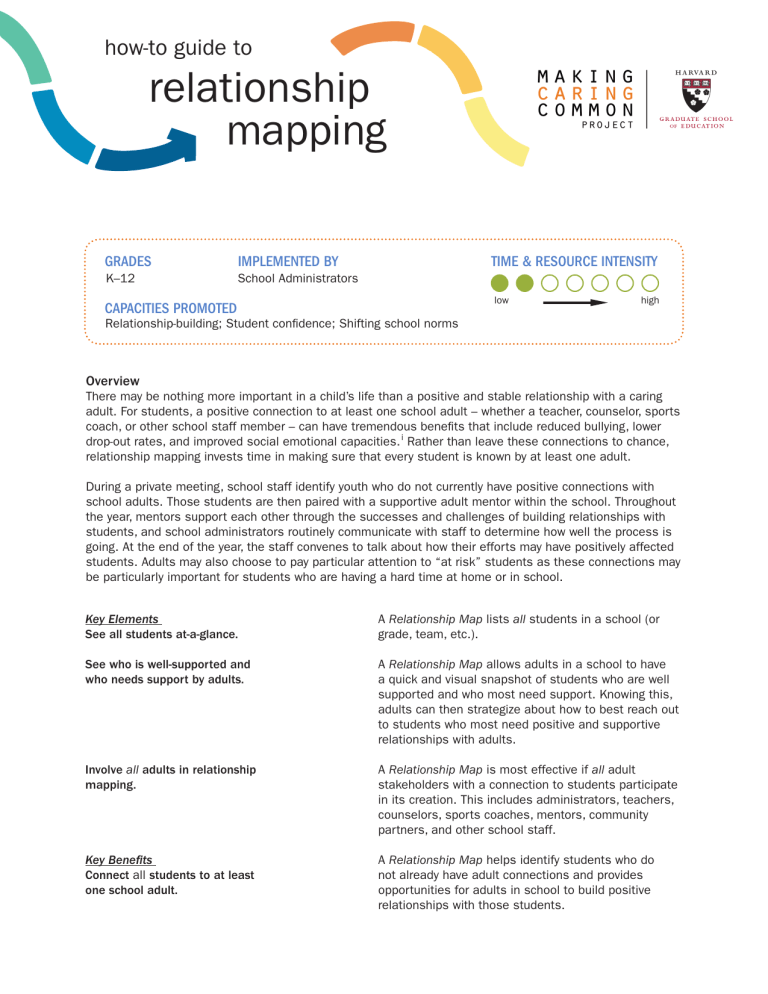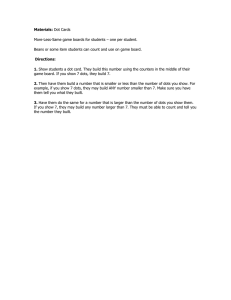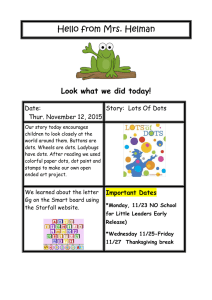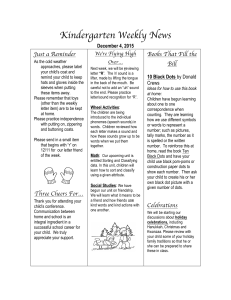
how-to guide to relationship mapping GRADES IMPLEMENTED BY K–12 School Administrators CAPACITIES PROMOTED TIME & RESOURCE INTENSITY low high Relationship-building; Student confidence; Shifting school norms Overview There may be nothing more important in a child’s life than a positive and stable relationship with a caring adult. For students, a positive connection to at least one school adult – whether a teacher, counselor, sports coach, or other school staff member – can have tremendous benefits that include reduced bullying, lower drop-out rates, and improved social emotional capacities. i Rather than leave these connections to chance, relationship mapping invests time in making sure that every student is known by at least one adult. During a private meeting, school staff identify youth who do not currently have positive connections with school adults. Those students are then paired with a supportive adult mentor within the school. Throughout the year, mentors support each other through the successes and challenges of building relationships with students, and school administrators routinely communicate with staff to determine how well the process is going. At the end of the year, the staff convenes to talk about how their efforts may have positively affected students. Adults may also choose to pay particular attention to “at risk” students as these connections may be particularly important for students who are having a hard time at home or in school. Key Elements See all students at-a-glance. A Relationship Map lists all students in a school (or grade, team, etc.). See who is well-supported and who needs support by adults. A Relationship Map allows adults in a school to have a quick and visual snapshot of students who are well supported and who most need support. Knowing this, adults can then strategize about how to best reach out to students who most need positive and supportive relationships with adults. Involve all adults in relationship mapping. A Relationship Map is most effective if all adult stakeholders with a connection to students participate in its creation. This includes administrators, teachers, counselors, sports coaches, mentors, community partners, and other school staff. Key Benefits Connect all students to at least one school adult. A Relationship Map helps identify students who do not already have adult connections and provides opportunities for adults in school to build positive relationships with those students. i Help the most “at risk” students – including those you may not notice day-to-day. A Relationship Map helps identify and support students most “at risk” academically, socially, or personally. This may include students with “loud” behavior issues, but it also helps identify children with “quiet” problems like depression, anxiety, or loneliness who may feel adrift at school and might otherwise slip under the radar. Degree of Difficulty Relationship mapping is easy to do. Depending on the size of your school or grade-level team, it may require only: yy 1 hour of school administrator advanced preparation for a staff meeting yy 1.5 hour whole-staff meeting yy Follow-up meetings as needed yy Varying times that adults will dedicate to students in need Blue, D. (2004). Adolescent mentoring. Issue Brief: Study of High School Restructuring, 1(3), 2 – 5. DuBois, D., Neville, H., Parra, G., & Pugh-Lilly, A. (2001). Effectiveness of mentoring programs for youth: A meta-analytic review. American Journal of Community Psychology, 30(2), 157 – 197. Making Caring Common Project Harvard Graduate School of Education 14 Appian Way Cambridge, MA 02138 Phone: 617-385-9544 www.makingcaringcommon.org how-to guide to making caring common relationship mapping GRADES IMPLEMENTED BY K–12 School Administrators CAPACITIES PROMOTED project TIME & RESOURCE INTENSITY low high Relationship-building; Student confidence; Shifting school norms Objectives To identify students who do (or do not) have positive and stable relationships with adults in school. To connect at least one adult in school to every student who does not currently have a positive and trusting relationship with an adult. Time Required 1 hour advance preparation for staff meeting 1.5 hour initial staff meeting Follow-up, as needed Varying times that school adults will dedicate to a student in need Materials Required Faculty room or other meeting space large enough for a whole-staff meeting that is not accessible to students on the day of the meeting Bulletin board, white board, or posters with student names posted Rolls of colored dot stickers: red and yellow (or colored markers to draw dots) Advance Preparation Inform staff of the purpose of the activity — via memo, email, or other communication — and what to expect. Schedule a time conducive to bringing all school staff together. If possible, require all adults in the school to attend – including teachers, counselors, coaches, support staff, and others. On the morning of the meeting, post the names of all students organized by grade-level and last name on the bulletin board or white boards in the meeting room. Ensure that the room is not accessible to students that day. Provide instructions in advance and post them in the meeting room. (See below). Provide rolls of yellow and red dots in the meeting room. Other Considerations Scheduling. This activity is best scheduled in October (once staff have gotten to know students and their needs a little bit) and then again in March (in order to assess progress and make any adjustments before the end of the school year). Scale. In smaller schools, this activity may be conducted for all students at once. In larger schools, consider conducting Relationship Mapping in grade-level teams. 1 Implementation STEP ONE: MAPPING (20 – 30 minutes) Require all faculty and staff to stop by the meeting room in advance of the meeting in order to carefully consider their relationships with each student. Post the following directions near the chart of student names: Please place a yellow dot to the left of the name of any student with whom you have a positive, trusting relationship and whom you believe would come to you if they had a personal problem. CONSIDER THIS Make sure that the staff has sufficient time to spend “mapping” in advance. This may mean spreading the mapping over several days or providing coverage for classroom teachers. Place a red dot to the right of the name of any student you believe may be at risk for academic, personal, or other reasons. Pay particular attention to students you teach or work with, but look at the full list to identify any student with whom you may have developed relationships. It is okay to place both red and yellow dots next to the same student’s name. Here is an example of how to set up A Relationship Map. List all students. Have adults place stickers next to students with whom they have a positive relationship and who they believe may be “at risk” academically, personally, or socially. Positive Relationship? Student Name At risk? Michelle B. CONSIDER THIS If possible, take the map off the wall before the framing conversation. This way, staff can be fully focused during the conversation. Also, unveiling the map during the summary portion of the meeting can be very effective. Mike S. Jake Z. STEP TWO: REFLECTIVE MEETING (60 – 75 minutes) Framing (15 – 20 minutes): Encourage each staff member to think of a positive relationship he or she had with a teacher or other school adult when he or she was a student. Ask them to spend two minutes writing down how this relationship affected them. 99 Next, ask staff to think of a positive relationship they have had with a student. Ask them to spend two minutes writing down how they believe this relationship affected the student. CONSIDER THIS Another resource for framing would be research findings about why positive relationships are important for students and for schools. Look at the Making Caring Common website for examples. 2 99 Ask for 2 – 3 volunteers to share first how they were affected by positive relationships in school: • Who were the relationships with? What made them meaningful? 99 Ask for another 2 – 3 volunteers to share how they believe students were affected by positive relationships with them: CONSIDER THIS Reviewing the map in silence is useful for people who are more internal processors, that is, people who want to think about what they want to say before they actually say it. • Who were the students? How did the relationships form? What made them meaningful? Reflections (20 minutes): 99 If the map has not been on the walls during the framing, post it now. Ask staff to carefully look at the map. Ask them to review it in silence for 5 minutes, thinking about two things: • What interesting or surprising details do you notice? • What questions or reflections does the map evoke? 99 Next, ask for 3 – 4 volunteers to share what they learned and what they wondered about. CONSIDER THIS Depending on the size of the school, you may decide to have staff reach out to students with only one yellow dot as well. If there is time, the facilitator may want to ask staff to comment on their reasons for giving red dots to students as part of action planning: What risks did staff identify? What kinds of support would be most effective? This can help match the right supports to students in need. Action Planning (20 minutes) 99 The meeting facilitator (most likely the principal or assistant principal) can read aloud the names of those students who do not have any positive relationships with an adult (i.e. students who have no yellow dots). Ask staff volunteers to reach out to these students. Next to the names of their respective students, make a record on the Relationship Map of the staff member who volunteered. For those students in need who are not initially matched with a staff volunteer, the facilitator should assign a coupling based on matching interests, schedules, etc. Prompt staff to think about: • What possible factors contribute to some students having more yellow dots than others? • What kinds of school-wide changes can be made to increase the number of yellow dots for students? 99 Next, the meeting facilitator can highlight students staff have identified as at-risk (i.e. students who have red dots). Even if these at-risk youth also have yellow dots, identify staff to connect with them. Prompt staff to think about: • What possible factors contribute to some students having more red dots than others? • What kinds of school-wide changes can be made to reduce the number of red dots for students? 3 • How can the staff work together to develop a climate that fosters meaningful connections among all students and staff? 99 For those students with a noticeably greater number of red dots and no yellow dots, it may be worthwhile to consider assigning them multiple mentoring adults. 99 Refer to the Questions for Reflection at the end of this document as a guide to producing meaningful, reflective discussion. Closing (5 minutes) 99 Re-emphasize the benefits of this activity – that fostering positive relationships with caring adults is critical for students’ academic, social, and emotional lives – and express appreciation for the commitment of staff to prioritize these relationships at this school. Make sure to sincerely thank the staff for their participation in the Relationship Mapping exercise and the conversation. CONSIDER THIS To assist with follow-up, mark a reminder on the school calendar for four weeks after the reflective meeting and then again four to five months after the initial reflective meeting. Do this immediately after the reflective meeting ends. STEP THREE: FOLLOW-UP (30 – 60 minutes) 1st Follow-Up: Approximately four weeks after the first reflective meeting, reconvene all staff who committed to reach out to disconnected students (those who lacked yellow dots and those who had red dots). This will provide participating school staff with a supportive community with whom they may share the challenges and successes of connecting with students. During these conversations, facilitators should find out two things: • Was a connection made with each student? • Did the student respond positively? If a connection has not been made, the group should discuss ways to overcome challenges and strategies for making connections with students. If a connection was made but the student did not respond positively, the facilitator and staff member – perhaps in conjunction with a school counselor – can discuss alternative strategies. CONSIDER THIS In addition to these two formal follow-up activities, administrator should be mindful of conducting regular informal check-ins with staff and students. 2nd Follow-Up: One to two months after the reflective meeting, the Relationship Mapping facilitator should again reconvene staff members who committed to reach out to students to determine if connections have been sustained and if progress has been made. 4 “ While our school had traditionally really excelled in academics, the social and emotional life of the students had not been as big a priority. We’d heard about the idea of ‘relationship mapping’ and decided to give it a try. When we were done, there were definitely some students who had no dots, or very few dots, next to their name. Among those kids, we were all very surprised to find academically high-achieving students, as well as kids who were struggling socially. We made plans as a school to engage all the students who were disconnected from the adult community. In addition to making sure that their advisor reached out to pull the kids in, for each child we identified at least one other adult in the community, usually a teacher or a coach, who would take steps to build a sustained, meaningful relationship as well.” — Doug Neuman, School Counselor Buckingham Browne and Nichols School Cambridge, MA ACTIVITY VARIATION FOR LARGE SCHOOLS In schools that are very large or where there may be concerns about finding a confidential space to post student names, it may be desirable to do the mapping part of this activity through an online system. Here are some tips for doing this:Using a survey or online system to which all staff have access, list the names of all students organized by grade level and last name. Next to each name provide two check-boxes: One to indicate that the staff person logging in has a positive and trusting relationship with this student, another to indicate that the staff person believes this student may have significant personal, academic, or other risk factors. Have staff login securely to the survey or system and complete the survey prior to the Reflective Meeting. Assign an administrator, instructional technology staff member, or other staff member to review the results and flag those students who were identified as not having a positive relationship with any staff member as well as those identified as facing significant risks. Print out a list of these students and bring this list to the whole-staff Reflective Meeting. Follow instructions for Step Two: Reflective Meeting above. QUESTIONS FOR REFLECTION We suggest using these questions throughout the process, but especially during the Reflective Meeting as the group is summarizing findings and making action steps: Which students or groups have the greatest number of yellow dots? That is, which students are most connected to adults? Why would this be? Which students or groups have the greatest number of red dots? That is, which students are most at risk? What are the likely reasons for this? 5 What barriers are keeping the disconnected students from having positive relationships with adults? Consider structural barriers, staff-imposed barriers, student-imposed barriers. How could we overcome these barriers? Which adults are best positioned to reach out to disconnected students? Why? What strategies might be most helpful in reaching out to disconnected students? How can we individualize our efforts and tailor them to specific students? What challenges are we most likely to encounter in reaching out to disconnected students? How can we address them? Can we engage other students in the process? Beyond reaching out to specific students, what else can we do to change our school culture so that all students feel connected to adults in the future? EXTENSION ACTIVITIES Given that adults’ perceptions may not always align with students’ perceptions, it may be useful to also have students identify the adults they feel connected with. You may choose to adapt the adult relationship mapping activity by listing all of the adults in school and have students turn in a notecard identifying the adults they feel connected to. Alternately, you could use an online or paper survey to poll students. Comparing student and adult perceptions may provide valuable information to ensure that all students feel connected to at least one adult at school. The following resources provide additional information and suggestions for connecting to students: Sears, N. Building Relationships with Students. National Education Association. Retrieved from www.nea.org/tools/29469.htm Swain, C. (2011). The care and support of teenagers. Education Leadership Online, 68. Retrieved from www.ascd.org/publications/educationalleadership/jun11/vol68/num09/The-Care-and-Support-ofTeenagers.aspx Warshof, A., & Rappaport, N. (2013). Staying connected with troubled students. Education Leadership, 71(1). Retrieved from www.nancyrappaport.com/downloads/ Educational%20Leadership%20-%20Staying%20Connected.pdf making caring common project 6



